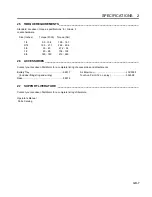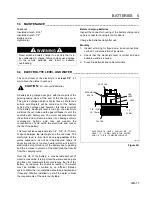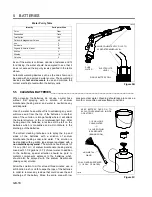
5 BATTERIES
GB-16
5
BATTERIES
5.1 SAFETY __________________________________________________________________
Batteries contain dilute sulfuric acid which can result in severe burns.
Hydrogen gas is formed within a battery during the charging cycle. Hydrogen in concentrations of 4% and higher are
explosive and can be ignited by open flame or an electrical spark. A battery explosion will cause sulfuric acid and
battery components to be thrown over a large area with considerable force.
Always observe the following warnings when working on or near batteries:
5.2
GENERAL ________________________________________________________________
Temperature is important when conducting tests on a
battery and test results must be corrected to compensate
for temperature differences.
As a battery ages, it still performs adequately except that
its capacity is diminished. Capacity describes the time
that a battery can continue to provide its design amperes
from a full charge.
The batteries most commonly used in golf and utility
vehicles are lead acid.
A battery has a maximum life, therefore good
maintenance is designed to maximize the available life
and reduce the factors that can reduce the life of the
battery.
WARNING
The electrolyte in a storage battery
is a dilute acid which can cause
severe burns to the skin and eyes.
Treat all electrolyte spills to the body
and eyes with extended flushing
with clear water. Contact a physician
immediately. Always wear a safety
shield or approved safety goggles when adding water
or charging batteries.
Hydrogen is explosive in concentrations as low as 4%
and is generated in the charging cycle of electric
vehicles. Because it is lighter than air, it will collect in
the ceiling of buildings necessitating proper
ventilation. Air exchanges of 5 changes per hour is
considered the minimum requirement.
Never smoke around batteries.
Never charge batteries in an area that has open flame
or electrical equipment that could cause an electrical
arc.
Be sure that the key switch is off and all electrical
accessories are turned off before starting work on
vehicle.
Remove all jewelry (watches, ring etc.)
!
!
TR016
WARNING
Wrap wrenches with vinyl tape to
prevent the possibility of a dropped
wrench from ‘shorting out’ a battery,
which could result in an explosion and
severe personal injury.
Use care not to tip batteries when
removing or installing them; spilled
electrolyte can cause burns and damage.
Electrolyte spills should be neutralized with a solution
of 1/4 cup (59.1ml) of sodium bicarbonate (baking
soda) dissolved in 1-1/2 gallons (5.7 liters) of water
and flushed with water.
Overfilling a battery could result in electrolyte being
expelled from the battery during the charging cycle.
Electrolyte may cause personal injury, damage to the
vehicle or damage to the storage facility.
Overfilling the batteries will void the vehicle and
battery warranties.
Never disconnect a circuit under load at a battery
terminal.
Wear appropriate protective clothing when working
with batteries. Electrolyte can cause severe burns to
the eyes, skin and clothing.
Batteries are heavy. Use proper lifting techniques
when moving them. Always lift the battery with a
commercially available battery lifting device
!
!
TR017
















































